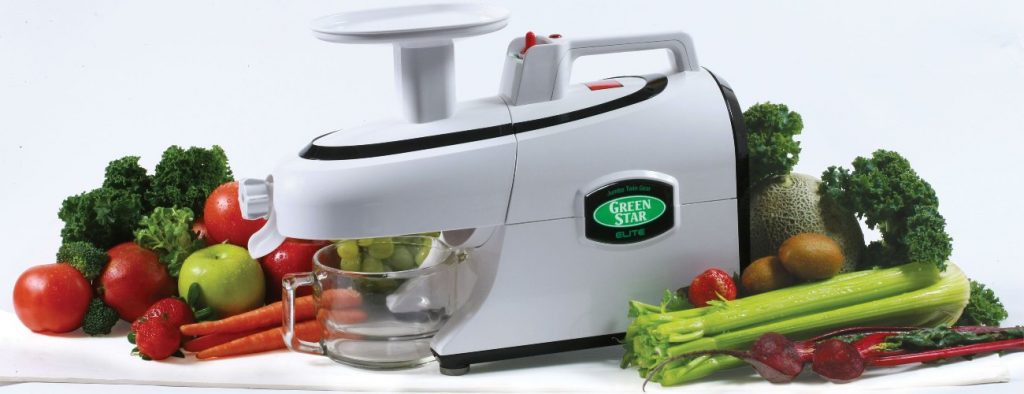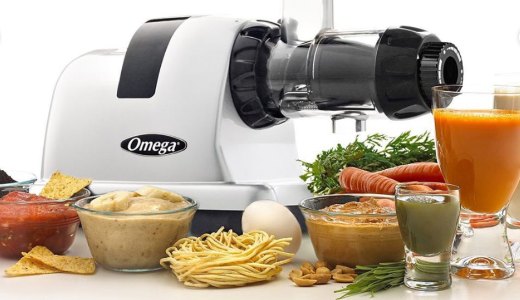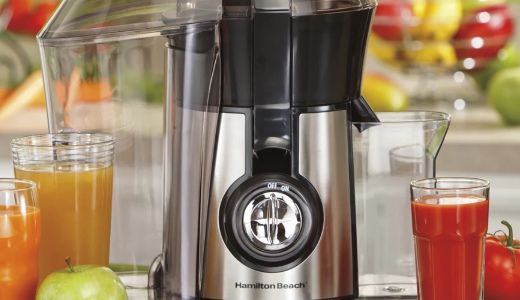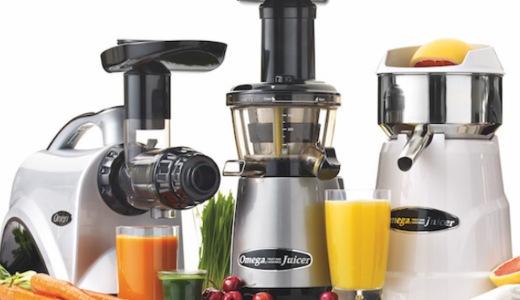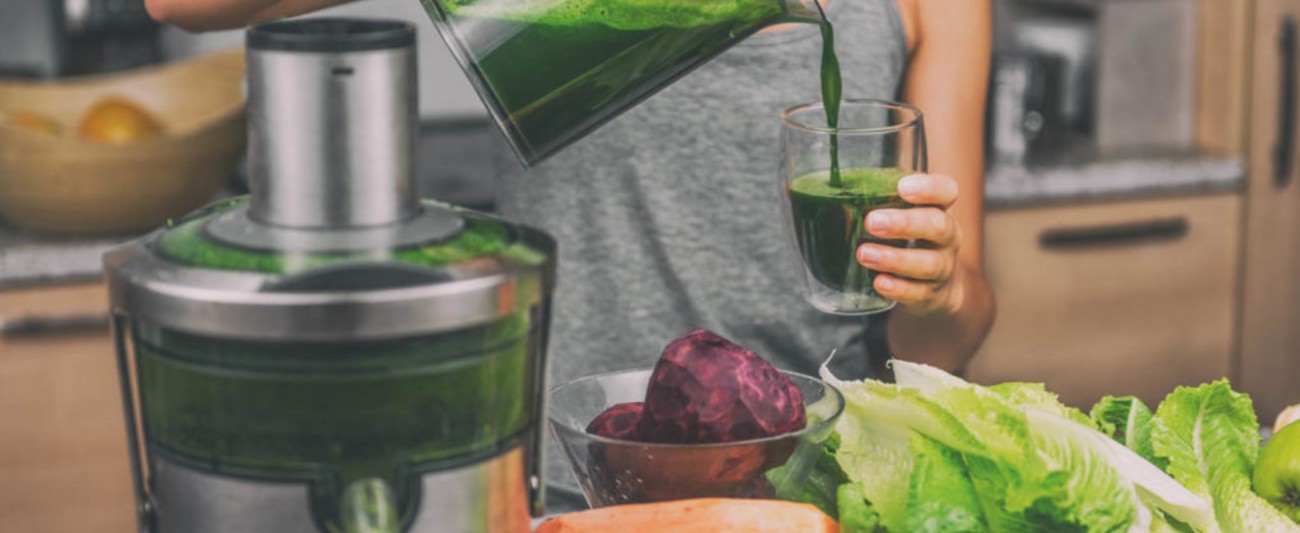Are you looking for the very best when it comes to at-home juicing? If so, you cannot beat the top-tier features provided by twin gear juicers. These units can rub, grind, and pound your favorite produce into a flavorful liquid without causing it to lose any of its texture or nutrients.
We’ve taken the time to review several of the top triturating juicer models on today’s market while also answering several of your burning questions about the specifications that make these models the best in their class.
If you’ve been researching, you’ve probably heard this about twin gear juicers. They are the best at getting the ultimate in nutritious juices out of fruits and vegetables.
A twin-gear juicer is also known as a triturating juicer, which means it’s a juicer that can rub, grind, and pound fruits or vegetables into fine particles. That’s important because it helps to extract essential nutrients and enzymes.
There’s another reason why these types of juicers are so popular. They are versatile enough to make other things, such as baby food, sorbets, and even nut butter.
I’m fascinated by these juicers, so I decided to do a deep dive and review the most popular twin gear juicers.
Before we get my thoughts on these juicers, I want to share three observations about twin gear juicers in general:
- 1. It takes longer to extract juice compared to the considerably quicker centrifugal juicer.
- 2. This type of juicer is generally more expensive than a regular single gear juicer.
- 3. The juice always looks and tastes much better than other types of juicers.
Contents
What is Twin-Gear Juicer?
I’ll admit, the first time that I heard about “twin gear juicers,” I wasn’t exactly sure what set them apart from other types of at-home juicing appliances. But now that I’ve used them for several years in my kitchen, I can firmly say that they possess numerous benefits compared to other types of juicers.
But let’s not get too far ahead of ourselves. Let’s start by understanding what twin gear juicers are at their core.
Twin gear juicers (also known as “triturating juicers”) are a type of masticating juicer. Triturating juicers is the fancy name for what we call twin gear juicers or double auger juicers. “Triturate” is a significant and medical-sounding word, but it’s another way to describe the action of finely grinding or crushing – and that is precisely what these juicers do.
They triturate by using two augers. The extraction process is so efficient that it leaves the expelled pulp with practically no moisture left.
You can expect these units to operate at moderate speed, just 80 to 110 RPM, thus allowing for higher juice yields from more “fragile” produce, including kale and wheatgrass. This helps to preserve the nutrient quality of the extracted juice, which can be stored for up to 72 hours.
These juicers use a three-stage juice extraction process. First, it crashes, and then it squeezes the fruits or vegetables twice. The two stainless steel auger gears have minuscule amounts of space between them, around 0.1mm. They crushing fruits and veggies an ideal atmosphere for squeezing out every last precious drop of produce juice – at a more efficient rate than any other juicer.
This maximizes the juice yield as well as the nutrients you can get from the juice. You can tell with the naked eye. The juice is always dense and has very vibrant colors.
This action tears open the product’s cell membranes resulting in a deep-colored juice rich with minerals and nutrients.
Basically, the twin-gear juicer is a cold-press machine as well. It works along with the same fashion as a single-gear masticating juicer. The appliance extracts liquid from fruits and vegetables with powerful pressing action.
This architecture comes with several noteworthy benefits that knowledgeable at-home juice makers will surely appreciate.
For example, twin gear juicers are among the very best options when it comes to processing leafy green produce. Also, juice made in a twin gear juicer tends to come out with more firm texture, regardless of what types of produce you’ve inserted into the mix.
For a better understanding of how the different juicers work, take a look at my post: Types of Juicers. But basically, the twin gear is the king of home juicers with regards to juice quality and versatility.
That quality comes with a price – literally. This type of juicer can be expensive, starting at $450 and climbing to over $1,000.
Why Should You Buy a Twin Gear Juicer?
You’re into juicing because you want the health benefits that can be extracted from fruits and vegetables. The twin gear juicer excels at this.
The reason? A twin gear juicer has two metal gears, and two augers are definitely better than one. The juicer will last longer, and it’s rugged enough to handle everything from the softest of fruits to fibrous green vegetables such as celery.
You’ll pay more for this type of juicer, but the twin gears make it more versatile than other juicers.
They preserve more of the nutrients and essential enzymes found in produce. Regular juicers tend to lose some during the extraction process.
Pros and Cons of Twin Gear Juicers
A twin-gear juicer features not one, but two metal gears. It lasts longer and can handle nearly anything you want to juice – from some soft fruits to green vegetables — even celery.
Celery was getting a lot of attention lately. The vegetable is loaded with a couple of important antioxidants, known as apigenin and luteolin, which been shown to reduce inflammation.
Advantages
- These are versatile juicers. Extract juice from fruits and veggies with ease. But branch out and try leafy greens, too.
- You get concentrated and high-quality juices that taste fantastic. This type of juicer extracts well from soft and leafy vegetables, including alfalfa sprouts and wheatgrass. In fact, it makes green juices sweet. Are you mostly into greens? Consider going with a twin-gear.
- It operates silently compared to a centrifugal juicer.
- It’s a top choice for dense green veggies or leafy greens. Want to juice something softer?
- The low-speed motor eliminates oxidation and preserves enzymes.
- The extraction method exposes cell membranes to release more nutrients.
- Juice remains stable and can be stored refrigerated for up to 72 hours.
- This juicer type produces a higher yield and drier pulp.
- The extracted juice has almost no foam.
Disadvantages
- A twin-gear juicer may not be the right option for a beginner or those on a budget due to its price. The price is from a bit more than $400 to over $1,000.
- There’s a smaller feeding chute, but it serves to help you feed the juicer too quickly and overwhelm the extraction process
- There’s generally longer prep time. You can’t be in a hurry for your juice!
- It’s faster than a masticating juicer, but still much slower compared to a centrifugal juicer.
- It’s important to follow instructions for proper operation.
- Cleaning can be challenging.
- The appliance is heavy (13 to 26 pounds) and may be cumbersome to move.
- It isn’t the best at juicing citrus fruits.
Best Twin Gear Juicers Reviews
You may have searched far and wide, but you’re unlikely to find a more comprehensive collection of the best twin gear juicers online. That’s because I’ve taken the time to check out each of these juicers on their own and evaluate them against a reliable set of standards. I’ve even graded each model based upon some of the most critical performance categories.
At the end of the day, these reviews should make it easier to find a juicer model that fits your budget. The pros and cons listed with each review should allow you to find a great option with a glance.
The Best Overall Twin-Gear Juicer
Tribest GSE-5000 Greenstar Elite
Though it may be the standard in its class, this juicer has a lot to offer. This model’s magnetic twin gears excel when it comes to extracting high yields. Meanwhile, this juicer’s cold press system excels at preventing nutrient loss.
Tribest GSE-5000 Ratings
Design: 8.0 –This juicer’s white case is stylish and easy to clean. You’ll even be able to transport it from place to place using its built-in handle.
Features: 8.0 – You’ll only find a couple of special features on this model that includes a food processing mode. Even so, you’ll find that these features work perfectly over its full lifespan.
Performance: 8.5 – This model performs like a dream. Its extraction system imitates human chewing, which allows it to draw out huge yields.
Usability: 8.0 – This juicer is very intuitive, starting with its broad feed chute. Even using this model’s reverse function only requires the push of a button.
Pros
- Magnetic twin gear system made from specialized bio-ceramic steel
- Pocket recessing and cutting imitates human chewing and allows for higher yields
- Massive 15-year warranty outpaces more expensive models
- Comes with a brush and scraper tool for easy cleaning
Cons
- The screen requires a bit of extra cleaning
- Sometimes ships without additional accessories
As soon as you pick up this juicer, you’ll notice its vibrant white case. In terms of design, this case allows this juicer to remain stylish while repelling corrosive fruit juices with ease. This case also includes a handle that makes it easy to transport this juicer. This handle is part of the main argument, so it also isn’t prone to breaking off.
When it comes to features, this juicer doesn’t possess a broad arsenal. Even so, you’re sure to find many uses for this model’s food processing mode. Also, you’ll surely taste the difference with this model’s juice. That’s because its cold press module preserves more flavor and nutrients than similarly-priced models.
You’ll be surprised at how well this juicer performs with almost any type of produce. That’s because of this model slices, cuts, and grinds all at once – just like human teeth.
As such, you can always expect this model to return large yields. You’ll also find this model very usable, as its reverse function handles clogs in mere moments.
Bottom Line:
Few, if any, other juicers can beat this model when it comes to value. For a very modest price, you get an exceptional twin gear unit that includes a cold press module. Better yet, this model’s 15-year warranty makes it a wise long-term investment.
Click here >> to check the latest price on Amazon.
The Best Quality Triturating Juicer
Super Angel Pro Stainless Steel Juicer
Don’t get sticker shock – this juicer is more than just a price tag. This model is very durable because of its high-grade steel body. Also, this model’s speed settings allow it to juice produce and prevent clogs at the same time.
Super Angel Pro Juicer Ratings
Design: 9.0 – This juicer is beautiful, plain, and simple. It’s also durable on all fronts, including its stainless steel case and its inclusion of Pyrex collection cup. Simply put, you will have a hard time damaging this juicer!
Features: 8.0 – This model’s thermal sensor is one unique feature. It ensures that this model’s internal heat does cause it to become inefficient. If that happens, this model can cool itself down without user input.
Performance: 7.0 – This juicer lags a bit when it comes to performance. That’s because its 83 RPM top speed is noticeably slower than competing models.
Usability: 8.0 – Using this juicer is relatively easy from the get-go. That includes when it’s time to clean up, so long as you use the special brush that comes packed in with this unit.
Pros
- Pro model’s exterior is made entirely from 18-8 “high grade” stainless steel
- Anti-jamming system and self-adjusting speed control proactively prevent clogs
- 82 RPM top speed prevents unnecessary oxidation
- Comes with a Pyrex collection cup and premium brush that makes cleanup a breeze
Cons
- Costs 2x to 3x as much as competing models
- Stainless steel body requires regular shining to prevent luster loss
Shiny – that’s the first word that comes to mind while looking at this juicer. But this unit is more than visually pleasing. Its case is made entirely from ultra-strong stainless steel that will never dent or crack. This model even comes with a Pyrex glass collection cup that won’t shatter if dropped.
You’ll find that this juicer rarely becomes clogged. That’s because it includes an anti-jamming system that breaks up clogs before they cause the blades to slow down. Also, this model’s thermal sensor ensures that the motor’s heat never impacts your juice’s nutrients.
If you’re new juicing, you won’t have trouble learning this model’s control panel. You’ll be able to identify its safety sensors after just one look at the unit. These factors make this juicer very usable, as does the inclusion of a special cleaning brush.
Bottom Line:
If you’re shopping on a budget, steer clear of this pricy juicer. But if you have some money to spare, you’ll find that this juicer’s durability allows it to last past its 10-year lifespan. Performance aside, this model also stands out when it comes to preventing bothersome jams.
Click here >> to check the latest price on Amazon.
The Best Value Triturating Juicer
Green Power KPE1304
This juicer’s top speed allows it to process more than just fruits and vegetables. At the same time, it manages to remain quiet while in use. This juicer even comes with a DVD to get new users up to speed.
Green Power KPE1304 Ratings
Design: 8.0 – While it may not be as pretty, this juicer is made from something special – recycled plastic, which allows it to be more lightweight overall. But in return, it is less durable when dropped.
Features: 9.0 –You won’t need a separate food processor if you buy this juicer. That’s because it can be used to grind the coffee, chop peppers, and so much more. In fact, it can do all of that without any special add-ons.
Performance: 7.0 –Despite its high top speed, this model has some trouble processing dense produce. As such, you might end up with some extra pulp when working with beets or carrots.
Usability: 8.5 –You’ll be able to learn how to use this juicer like a pro in mere minutes. After watching its packed-in DVD, you’ll even be able to make full use of this model’s bio-ceramic juicing jug.
Pros
- 160 RPM top speed can grind up coffee beans, hot peppers, and more
- Bio-ceramic juicing jug prevents oxidation for up to 72 hours.
- Comes with an informative DVD for new users
- Constructed mainly from recyclable materials
- Easy to transport due to lightweight and ergonomic handle
Cons
- The exterior is a little fragile
- Has some trouble with dense produce such as beets and carrots
While this juicer may not jump off the shelves for its appearance, its material makeup may serve as a significant selling point. As it turns out, this model’s dull gray exterior is made up of recycled plastic. On the one hand, this design choice makes this juicer eco-friendlier. On the other hand, though, it does tend to crack easily.
You’ll be able to use this juicer every day, even when you don’t need to make more juice. That’s because it can be used to make baby food for your little children as well as fresh-ground spices for your spice cabinet. It can even make perfect coffee grounds with the use of its crush screen.
After watching the DVD that comes with this juicer, you’ll be able to juice daily like a pro. You’ll also be able to make full use of this model’s accessories that includes the bio-ceramic juicing jug, which can preserve juices for up to 72 hours.
Bottom Line:
You’ll probably be most interested in what this juicer is made out of – recycled plastic. But that doesn’t mean it can’t become a regular fixture in your kitchen. For an affordable price tag, you’ll get a unit that can do more than just juice without sacrificing its core capabilities.
Click here >> to check the latest price on Amazon.
The Best High-End Triturating Juicer
Super Angel DELUXE
Super Angel DELUXE juicer costs a pretty penny. But for that price, you get a powerful crushing and grinding system that never overloads. Better yet, this unit rarely jams. You’ll even be impressed with its extended warranty – 10 years, plus five extra years for wear and tear.
Super Angel Deluxe Ratings
Design: 9.0 – This model sure does shine. But its silvery case isn’t just beautiful. It’s also durable because it is made out of .304 gauge stainless steel. As such, you’ll be able to use this model for far longer than its ten-year lifespan.
Features: 8.5 –Some of this model’s most simple features allow it to stand out. For example, this model can reverse its operation when it senses a jam. Also, its new control board can adjust its speed seamlessly.
Performance: 7.5 –This model performs reasonably well, though I would expect more from such an expensive unit. In particular, this model is a master at processing soft fruit without creating a mess. It will likely generate a bunch of foam in the process, though.
Usability: 7.5 –You will need to polish this unit often if you want it to retain its shine. But otherwise, cleaning this juicer is fairly easy thanks to its purpose-made brush.
Pros
- Built with durability in mind, including high-grade stainless steel exterior and Pyrex collection cup
- Special soft fruit extraction housing handles certain produce with care
- Newly upgraded electronics
- The automatic cooling system allows for self-preservation
- Ten-year warranty includes five extra years of coverage for wear and tear
Cons
- Very expensive
- Creates a lot of foam
Many folks are drawn to this juicer based on its chrome-like appearance. But this small design element hides how truly durable this unit is. It’s made from .304 gauge stainless steel that will likely never dent or crack. Even this model’s flared feed chute is made from this extra resilient metal!
When it comes to features, this juicer has many of the best. This model’s cooling system is a prime example. It can sense when the motor is running hot. In turn, it kicks on and prevents that heat from damaging the unit or your processed juice.
This juicer’s performance is at its best when soft fruits are inserted. That is because this model has been redesigned with a special housing that prevents soft fruits from becoming an internal mess. You’re sure to taste the difference, too, given that these fruit juices always come out darker and more vibrant than from other models.
Bottom Line:
This juicer might be more expensive than most are willing to pay. But if you choose to do so, you’ll get a unit that is as strong as it is pretty. While it may have a few performance issues, it is generally a worthwhile long-term investment.
Click here >> to check the latest price on Amazon.
The Best Commercial Twin-Gear Juicer
Tribest Greenstar Pro GS-P502
Tribest Greenstar Pro GS-P502 juicer is one of the easiest to handle in this class. Its quick latch system is a thing of beauty, as is its cold press technology. It also comes with a bunch of accessories, as well as a 15-year warranty.
Tribest GS-P502 Ratings
Design: 7.5 – This model’s grey case might not blend in with your kitchen décor. But still, it is plenty durable enough to last for 15 or more years without trouble. That takes into account carrying this juicer from place to place via its wide handle, too.
Features: 7.5 – This juicer is a bit sparse when it comes to features. Even so, its twin gears will do a serviceable job if you’re planning to grind up other foods.
Performance: 8.5 – This model’s use of cold press technology is superb. The same can be said of this model’s twin gear when they operate at 110 RPM. As a result, every cup of juice that comes out of this unit has an ideal balance of pulp and flavor.
Usability: 9.5 – This juicer tops the charts when it comes to usability. That’s because its quick latch system allows for easy access to the internal augers and gears. This, in turn, makes cleaning up with this model’s brushes a breeze.
Pros
- The quick latch system allows for quick access to gears and augers
- Comes with scrapers, plungers, and specialty screens
- Incorporates cold press technology
- Exceptional 15-year warranty
Cons
- Designed for commercial use and price reflects this
- Tools are bit flimsy
While it may not win any visual design awards, this juicer could stand up to a stress test. That’s because its exterior is reasonably resilient. It can even withstand acidic fruit juices time and again. Even this model’s handle is worth noting, not least because it won’t dig into your hand while transporting the unit.
While it may be light on features, this model’s performance is very worthwhile. This is especially true of its cold-press technology, which excels at locking in nutrients. This model’s yields are also some of the best, even when working with leafy produce that doesn’t contain much juice per leaf.
Finally, cleaning up this juicer could not be easier. Simply engage its quick latch system, and you’ll have this unit’s auger out in seconds. Then, using a simple cleaning brush, these stainless steel components rinse off with little need for extra soap. The scraper tool that comes with this unit can also help in this cleaning endeavor.
Bottom Line:
This juicer is another worthwhile option if you want to keep a tight budget. It is, by far, one of the most convenient options in its class, particularly when it comes to cleaning. Its performance isn’t too shabby either, especially if you take full advantage of its cold press technology.
Click here >> to check the latest price on Amazon.
Features to Consider When Choosing a Twin Gear Juicer
Manufacturers all claim unique features that differentiate their juicer from competitors. Here’s what makes the difference.
Motor power: The slow and steady revolutions per minute (RPM) of the juicer’s motor might make you think that the appliance doesn’t need a big, heavy-duty motor.
These juice machines do require sufficient power – measured in wattage – to efficiently juice fruits and vegetables.
Rest assured that using your juicer even regularly isn’t going to give you sticker shock when you get your electricity bill.
The juice extraction process is dependent on sufficient power from the appliance’s motor – which would be between 150 to 200 watts. For comparison, the average hairdryer uses between 800 and 1,500 watts.
Speed: a twin gear juicer generally has the same speed as a masticating cold press juicer. Overall speed is determined by the size of the gears or augers.
Speed: Higher RPM = better? The speed of your juicer is measured in revolutions per minute. It’s an essential factor, but perhaps not in the way most people initially think!
Faster is not better. Rather than picking a high RPM twin-gear juicer, look for one that has a slower speed.
The lower speed of rotation will not disrupt the cellular structure of fruits and vegetables. It preserves essential enzymes and nutrients.
People often remark about how dark and rich the juice from these juicers look. It’s because slow is better. Choose the twin-gear juicer that offers 120 RPM and less.
Juicer size: Not all of us are lucky enough to have a kitchen big enough to keep all our favorite appliances out on the countertops for constant and quick use.
Triturating juicers can vary significantly in the amount of countertop space they’ll need.
If space in your kitchen is tight, be aware that twin gear juicers can be countertop hogs.
You should keep an eye on the dimensions and the structure of your twin-gear juicer if you are not planning to keep it on your countertop.
Many of these types of juicers feature add-on accessories that will take up even more space.
Take the time actually to measure the area where you’ll put your juicer, and then pay close attention to the juicer dimensions that each manufacturer provides.
Weight: Many people solve kitchen countertop space limitations by storing appliances in a nearby pantry area or cabinet.
It’s okay for a blender that might not weigh much, but most of these types of juicers weigh enough that you’ll want to leave them where you put them.
If you do plan on moving your twin gear juicer regularly, you’ll want to pay close attention to the overall weight of the appliance.
Accessories: Some triturating juicers feature attachments such as pasta makers, to extend the versatility of the appliance. Twin gear juicers are popular because they do an excellent job and they are versatile machines.
Most usually come with attachments that extend the juicer’s usefulness. One of the most popular accessories allows you to make pasta!
It’s up to you to do the research and find out which attachments come with the juicer you buy – and which will be additional purchases./p>
Materials used: There’s no getting around it – stainless steel or any material that resists corrosion is your friend.
Juicers that boast surgical grade or bio-ceramic steel material aren’t trying to get you to spend more money. These are important considerations.
Standard stainless steel may not be sturdy enough to provide you with the lifespan you should expect when you invest in a juicer like this.
Even stainless steel will discolor and rust when exposed to the acidity of certain fruits and vegetables. Don’t skimp on the quality of materials as you decide on a juicer.
- Look for a model that has been approved by the FDA.
- Avoid juicers that use plastic parts.
Anti-jam functions: The powerful motors in these juicers should prevent most jams. They may still happen if the juicer is misused or when you’re first getting used to using it.
Most manufacturers have included anti-jamming functions in their juicers. So you likely don’t have to worry too much about this.
However, not all brands offer reverse functions that allow you to use the power of the juicer’s motor to rectify jams.
Pulp ejection: the feature of a twin-gear juicer is one of its biggest differentiators from other juicers. The hallmark of a quality juicer is a pulp that’s as dry as possible. It’s an assurance that the triturating juicer has extracted as much nutrition as possible.
Assembly: you’re dealing with a juicer that has dual augers. You don’t need an engineering degree, but there is a learning curve involved in taking it apart and putting it back together again.
Commercial or home use: most models are built to be rugged, but it doesn’t mean they’re meant for commercial use.
Stability: a stable base and sufficient weight keep the juicer stable during operation.
Noise level: unlike a centrifugal juicer, a triturating juicer should be relatively quiet because of its super slow-spinning rate and its good motor design.
Cleanup: a triturating juicer is more efficient at extracting, but that means the cleanup is more involved. It’s important to understand that upfront, so you’re not frustrated by the extra time, it’ll take to keep your juicer clean and in top shape.
Most triturating juicers don’t have a lot of dishwasher-safe parts. You’ll be hand-washing it.
Durability and Warranty: Naturally, most manufacturers are going to say that their juicer is durable. Look for a brand that’s willing to put their money behind this claim by offering robust warranties.
Look for a company ready to protect your investment for at least five years. Some of the higher-end models protect for 10 to 12 years.
FAQ
What is a twin gear or triturating juicer?
The twin-gear or triturating juicer uses two augers instead of one (hence the name “twin”). It operates similarly to a masticating juicer or a cold press juicer – and like these juicers, it runs slower than a centrifugal juicer.
Can twin gear juicers process leafy greens?
Yes, absolutely! Masticating juicers of all types have long been the best option for at-home juicer makers who value a healthy glass of leafy green vegetable juice. But twin gear juicers specifically can process celery, kale, and spinach with an unmatched level of efficiency.
Even wheatgrass is no match for a twin gear juicer’s unique extraction system, which maximizes overall juice yields while removing an impressive level of pulp.
In the same vein, twin gear juicers are also prized for their ability to preserve nutrients within a fruit or vegetable’s juice. Compared to ordinary centrifugal juicers, which introduce heat and friction during the extraction process, twin gear juicers operate at a speed that doesn’t cause vitamins and minerals to break down or denature.
As such, every glass of juice from a twin gear juicer nutritionally matches your favorite fruits and vegetables without as much bulk.
Are twin gear juicers easy to clean?
Generally speaking, most twin gear juicers are relatively easy to clean. Most modern models utilize corrosion-resistant plastics, if not also dishwasher safe.
Most recent models also disassemble in a reasonably simplified manner, making it easy to clean up efficiently after your daily juicing session.
That being said, some users believe twin gear juicers (and masticating juicer, more generally) to be challenging to clean out easily. This is because twin gear juicers tend to have more internal corners and crevasses that require extra scrubbing or soaking.
Even so, an experienced at-home juice maker should have no trouble handling a new twin gear juicer when it comes time to clean up.
How long does the juice make with a twin gear juicer last?
As a rule of thumb, any homemade juice should be consumed within the first 24 hours to enjoy the best flavor and nutrient load.
However, juices made by a twin gear juicer are usually safe to consume for up to a week after production (so long as the juice is stored in a sealed container and kept in a refrigerator.) Results may vary from one juice mixture to another, though, as some fruits are more prone to spoilage than vegetable juices.
What are twin gear juicers best for?
You can use this juicer on nearly all types of vegetables and fruits, but they are especially effective at extracting juice from produce with harder consistency, like celery or apples.
And because of the extra horsepower of the motor, you won’t have to do as much pre-preparation. The slow RPM and precision of the twin auger gears slowly pull in fruit and vegetables and efficiently juice them.
Can I use these for anything else?
You can! Several twin gear juicer manufacturers specialize in multifunctional models that turn it into a versatile food processor.
The two Tribest models are designed for this. Consider these models if you’d like to branch out and make frozen sorbets, salsa from fresh tomatoes, nut butter from toasted cashews, or even pasta.
What kinds of vegetables can I process with a twin gear juicer?
The twin gear juicer can efficiently process wheatgrass and most leafy green vegetables, such as spinach, and herbs.
What are some of the best fruits to use for a triturating juicer?
Users report getting the best results from a triturating juicer with apples and pineapples. Since it also does well with hard produce and leafy vegetables consider creating a refreshing beverage made with all four of these ingredients!
What is the typical speed of a triturating juicer?
New users sometimes are concerned that there’s something wrong because the motor seems to be running so slow. The typical speed of a triturating juicer can be as low as 80 RPM. The slow movement is designed for high extraction efficiency.
Is it easy to clean up a twin gear juicer?
Not exactly, and this is a deal-breaker for some people. Don’t expect to throw the pieces of your juicer in the dishwasher. Or reassemble it after cleaning in a matter of seconds.
Your twin-gear juicer is made of parts that operate with precision. It must be cleaned regularly to keep it running efficiently. These types of juicers need more time and attention than even a masticating cold press juicer.
What is a blank screen on a juicer?
A blank screen is an option usually found on high-end and expensive juicers, and many twin-gear juicers have this attachment. It’s a unique screen that homogenizes what you’re extracting.
The best example would be peanut butter. If you want it creamy and consistent, the bland screen is your friend.
Are triturating juicers expensive?
These types of juicers are generally more expensive. Some can be even pricier than a cold press or masticating juicer. This is because the triturating juicer uses precision components not found in regular fast juicers like the centrifugal juicer.
Surgical grade steel: what are the advantages? Can it improve the flavor?
What tastes good is a personal measurement. But a quality twin gear juicer uses surgical grade steel because the components won’t rust or corrode. This makes more of an impact on the longevity of the juicer than the taste of the juice.
Personal opinions do count, though. Many owners claim that twin gear juicers make better-tasting juice because of the use of surgical grade steel rather than stainless steel.
Conclusion: What’s the Best Triturating Juicer for You?
I wouldn’t recommend a twin gear juicer for a noob. Not for snobby reasons, but because of the complexity and learning curve involved with this type of juicer.
Are you willing to put in the time to learn how to use and maintain it? Go for it! I wouldn’t stop you from buying one.
If you want quantity and quality, this will be one of the best investments you can make. And it is an investment because you can expect to pay significantly more than you would for an entry-level fast centrifugal juicer.
When you compare it to a single-gear juicer, you should always remember that it isn’t as easy to clean the twin-gear machine. It has two gears and more parts.
Go for it if you don’t mind the extra work and have some spare time in your hands. You won’t have many options, though. Only a few manufacturers make twin gear juicers.
The cost to manufacture these appliances puts them out of the budget for many. So, if you’re willing to spend not over $500 for a juicer, the Tribest GSE-5000 Greenstar Elite is an excellent option.
Other options
If the cost of the Tribest is too expensive, consider the Green Power KPE1304.It costs less but still delivers a wealth of features and added benefits. All you’re really giving up is versatility. This juicer is best at making only green juice (hence the name).
There’s a right third choice, too. It’s the Tribest Greenstar Pro GS-P502, which might grab your attention with its slick, modern design that matches its juicing properties.

